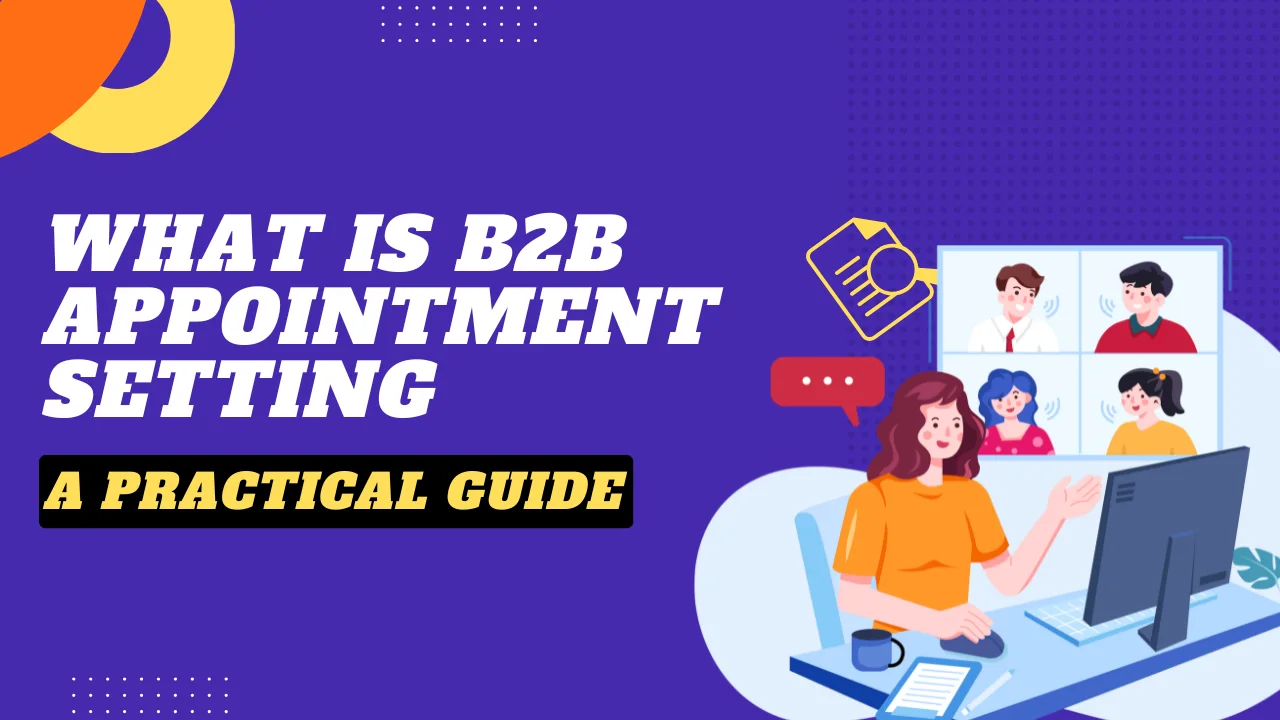If you’re trying to grow a B2B business, you’ve probably hit this problem: getting people to actually talk to you.
Not just open your emails. Not just fill out a form. You need real conversations — the kind that happen over Zoom or on a call, where both sides show up and talk business. That’s where appointment setting comes in.
This guide walks you through what B2B appointment setting really means — in plain English. No buzzwords. No sales-y language. Just clear steps and useful insights, especially if you’re doing this for the first time.
What Does “Appointment Setting” Mean in B2B Sales?
Let’s make this simple.
B2B appointment setting is the process of reaching out to potential business clients, talking to them (briefly), making sure they’re a good fit, and then getting them to agree to a meeting with someone on your team.
That’s it.
The person doing the outreach might be called an SDR (Sales Development Rep), or just an appointment setter. Their job isn’t to close the deal — it’s just to start the conversation and get the right people into a scheduled meeting.
In a small business, this could be a founder doing it themselves. In a larger company, there’s usually a team dedicated to it.
Why This Step is So Important
Let’s say you’re selling a B2B service — software, logistics, consulting, whatever.
You’ve got leads coming in. Maybe you’ve even bought a lead list. But what happens next?
If nobody is following up consistently, qualifying the lead, and getting that meeting scheduled, you’re just collecting contacts. Not sales.
Here’s why having a focused appointment setting process makes a huge difference:
- You stop wasting time on bad leads. A quick pre-call filters out the noise.
- Your salespeople talk to warmer prospects. That boosts their close rates.
- It gives your pipeline structure. You know what’s coming next week, not just hoping something closes.
What Does an Appointment Setter Actually Do?
This isn’t just about making calls. Good appointment setting has a rhythm to it.
Here’s what a typical week might look like for someone doing this full time:
- Build or get a lead list (from tools like Apollo, LinkedIn, or even just a spreadsheet)
- Send personalized emails or messages — not spam, but short, thoughtful ones
- Make cold calls (if calls are part of your channel strategy)
- Follow up with anyone who opened, clicked, or responded
- Ask qualifying questions to make sure the lead is worth the salesperson’s time
- Book the meeting on a calendar
- Confirm the meeting and remind them to show up
If someone says, “Call me next quarter,” they add that to a follow-up list. If someone says no, they move on. It’s not glamorous, but it works.
Common Mistakes New Teams Make
If you’ve never done this before, here are a few traps to avoid:
1. Thinking volume = results
Blasting 1,000 emails with no personalization is worse than sending 50 thoughtful ones. You might get replies, but they’ll rarely turn into real meetings.
2. Not qualifying before booking
Just because someone says “I’m interested” doesn’t mean they’re a fit. Always check: Are they in the right industry? Do they actually have a use case? Are they a decision-maker?
3. Letting meetings fall through
No reminder email? No calendar invite? That’s how no-shows happen. A 10-second reminder email can double your attendance rate.
How Do You Know Someone is Ready for a Meeting?
There’s no perfect formula, but here’s a quick mental checklist:
- Do they match your target customer profile?
- Did they show genuine interest or ask relevant questions?
- Are they someone who can say yes (or introduce you to the person who can)?
- Do they have a clear need for what you offer?
If you can tick 2–3 of these, they’re probably worth a conversation with your sales team.
Should You Do This In-House or Outsource It?
There’s no one-size-fits-all answer, but here’s a quick breakdown.
| Option | Pros | Cons |
| In-house | Control, alignment, culture fit | Time-consuming to train, manage |
| Outsourced | Fast setup, lower upfront cost | Less visibility, requires good handoff |
If you’re just starting out, sometimes it’s better to have someone else set up the process so you can focus on closing. Later, you might bring it in-house when you’ve nailed down the script and approach.
Tools That Make Appointment Setting Easier
You don’t need a fancy stack, but a few tools help streamline things:
- Email finder: Hunter.io, Apollo, or Snov.io
- Cold email sender: Instantly, Mailshake, or Lemlist
- CRM or pipeline tool: HubSpot, Pipedrive, or even Airtable
- Calendar tool: Calendly or Google Calendar with a booking link
Start simple. Complexity comes later.
Metrics You Should Actually Care About
Don’t get caught up in vanity numbers like “emails sent.” Instead, track:
- Reply rate — Are your emails getting interest?
- Booked meetings — Are people taking the next step?
- Show-up rate — Are they attending the meetings?
- Qualified meetings — Are they the right people?
If you’re booking 10 calls a week but only 2 are qualified, something’s off — maybe your messaging, your targeting, or your lead list.
Final Thoughts
B2B appointment setting isn’t a silver bullet. But when it’s done right, it removes the chaos from your sales process. It gives your team a steady stream of real conversations with potential buyers — which is the first step toward real revenue.
Start small. Build a repeatable system. Keep it honest and human. That’s all you need to get going.

1 thought on “What is B2B Appointment Setting? A Practical Guide ”